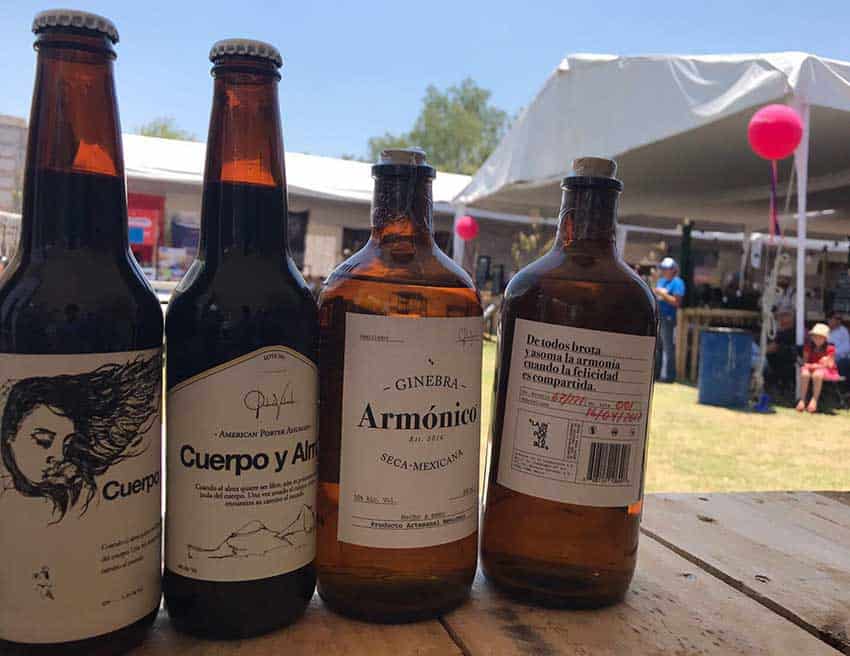Most 16-year-olds aren’t brewing their own beer, but Andrés Valverde was not just any teenager.
Now, at 24, he’s seeing his efforts pay off as his brews and distillations are being enjoyed across Mexico.
Originally from San Juan del Río, Querétaro, Valverde arrived in Mexico City on a basketball scholarship at the Tecnológico de Monterrey’s Tlalpan high school campus. He and his brother shared an apartment in Xochimilco.
Realizing that the bar was a costly place to visit for fun, he started to brew his own beer in their apartment. Now the brothers are partners in La Insoportable Cervecería y Destilería based in their hometown.
The business gets its name (it translates as “The Unbearable Brewery and Distillery”) from Milan Kundera’s novel The Unbearable Light of Being.

“All the while I was learning how to brew and how to distill and deciding that is the type of career I wanted, I was reading that book over and over again because I was drawn to its philosophy,” Valverde said.
“I want all of our products to have a message, a reason for why they were made; that there is something more to it than simply being an alcoholic beverage, a beer or a gin. That it has a philosophy as to why it was made, how it was made and why these ingredients were used.”
La Insoportable is working its way into becoming a tasting room right in San Juan del Río, and Valverde says he hopes to have the doors open to the public sometime this summer. Visitors will be able to sample Valverde’s American Pale Ale and Porter, as well as his most successful commercial hit thus far, Armónico gin.
Armónico (harmonic in English) is a nod to the balance in nature that must be reached in order for survival and also to supply the 32 botanical herbs, fruits, flowers and spices that the gin is comprised of. Valverde distills the artisanal product the same way he started in his Mexico City apartment — in copper stills.
The gin is sold in 500-milliliter bottles in an effort to encourage his customers to enjoy it fully, not just chug it down trying to catch a buzz.
“We use a lot of Mexican herbs and fruits that we grow in my grandparents’ garden, such as limes and rue,” Valverde said. “We also use honey from Michoacán and cinnamon from Tabasco.”
At first, Valverde struggled with deciding which path to take after high school and considered going to a university at the behest of his parents, wavering between studying fashion design or industrial design, but he was always drawn back to the beverage world.

On a trip to visit family in Sacramento, California, Valverde’s imagination was captured by the booming business of micro-breweries and distilleries, which would ultimately inspire his plans for a tasting room.
“Every corner you turn in Sacramento, or many cities in the United States, there’s a brewpub,” he said. “A place where they have the equipment and a tasting room, and that model really caught my attention as I visited several. I wanted to do that in Mexico and saw that craft beer was starting to catch on here. We’re still behind, but it has grown a lot.”
Valverde began giving basketball lessons in Mexico City in order to save money to study distillation and brewing in Chicago. There he was able to learn more about the equipment and the process needed for beer and liquor.
At age 20, he formed his company, La Insoportable, which he now runs with his brother and two other partners.
“I wasn’t sure which liquor I wanted to focus on, but when I came back to Mexico I saw that gin had exploded in popularity,” he said. “It was never a common beverage here, and now it’s really in style. I’d already made mezcal and tequila, and we all know those are Mexican liquors that you can find anywhere in Mexico. But this country has the potential to produce all kinds of things and I wanted to do something different. That, for me, was gin.”
Valverde began to develop his recipe and found the magic balance in December 2016. The following September, he obtained permits to legally sell Armónico in bars and restaurants across Mexico.
In 2018, the company started to sell to different regions of the country, including bars in Guanajuato, Guadalajara, Monterrey, Los Cabos and Riviera Maya.
The focus this year is investment of time and funds into the tasting room and production of gin and other products.
“I want people to understand the process,” Valverde said. “People say Armónico is expensive (530 pesos per bottle) but that is because artisanal distillation in Mexico is very costly for producers. We’re paying the same taxes that Hendrick’s, Tanqueray, Bombay and the big companies are paying, and I started with selling six bottles per month.
“I want people to appreciate the liquid that each bottle has inside. What we’re doing is invest in the distillery so we can begin making different products like whiskey, liqueurs, rum, beers, pulques, tequino, tepache. We want to be more focused on experimenting than commercializing our products.”
Valverde says the goal of La Insoportable Cervecería y Destilería, which has seven employees including himself, is not to industrialize the product to a point where it loses quality or the essence of experimentation. Creating small batches of something new and seeing if people like it is the best way of doing that, Valverde said.
Using the garden at his grandparents’ house in San Juan del Río, Valverde plans to offer seasonal liqueurs for use in specialized cocktails, distilling with pomegranates in the summer and marigolds in autumn.
In September 2017, Armónico was selling at a rate of six bottles per month. In December 2018, that number had grown to 350. La Insoportable hopes to reach 1,000 bottles per month by the end of 2019. The biggest challenge to reaching that goal is finding a distributor to support the product.
This means that Valverde does all the distribution in Mexico City, while another employee is charged with distribution around the country. Armónico can also be purchased online at Amazon México.
Armónico is not the only artisanal gin producer in Mexico. There’s Saturnal from Guadalajara, Enmienda from Tijuana, Del Rey from Aguascalientes and Katún from Yucatán, among others.
Once the tasting room is up and running and production has increased a bit, Valverde said he would like to start a non-profit organization which would invite Mexican distilleries to work together on forming initiatives such as lowering taxes on artisanal products and making sure that bars don’t prohibit small producers from entering because of financial pressures from larger companies. Another major goal for the organization would be to create tasting events across the country.
“One of the difficulties that small producers face is that there aren’t places which allow you to be visible without paying a large quantity of money,” Valverde said. “With La Insoportable, we want to invite other brands to engage in a healthy competition, kind of what they are doing a bit right now with craft beers — but with liquor.”
Megan Frye is a writer, photographer and translator living in Mexico City. She has a history of newsroom journalism as well as non-profit administration and has been published by several international publications.









